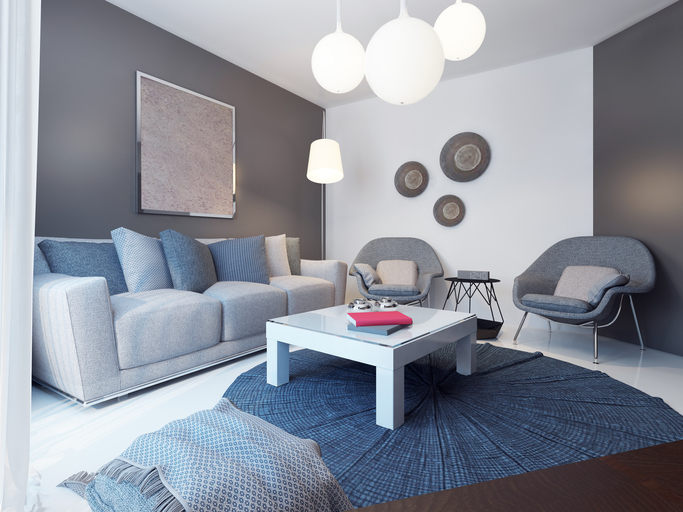
Whether you’re redesigning one room or your entire living space, there are ways to evoke specific emotions just by carefully selecting your wall color. By embracing the psychology of color, you can create a more lively living room, a creative kitchen, a calm and peaceful bedroom, or a studious-minded study. So go ahead, transform any room into your perfect vision.
Your choice of wall color can make an expansive room seem more intimate, or a too-small room appear a little larger. What atmosphere do you want to create?
We’ve gathered some enlightening information about how the wall colors in a room can affect your mood, your feelings, and even your actions.
What is Color Psychology?
Colors can affect our moods, including physical and emotional reactions. For instance, blue and green colors promote a relaxed, calm feeling, while yellows and orange colors can make us feel more energetic and productive.
Scientists, artists, and interior designers have been studying some form of color psychology for centuries. Long ago, some ancient Egyptian and Chinese cultures practiced light therapy (also called chromotherapy) using colors to heal ailments.
More than 350 years ago, Sir Isaac Newton, an English scientist, discovered all the visible colors when he passed pure, white light through a prism. In his groundbreaking research, he found that each color, on a single wavelength, couldn’t be separated. However, some color lights could be combined into new colors, such as red and yellow lights forming orange light.
Over the years, the knowledge gained from studying color psychology has helped drive advertising, marketing, and art. It has also changed interior design decisions, from offices to homes. Some color/mood beliefs have even made it everyday sayings, like “I have the blues” or “I’m green with envy.”
Colors Have Personalities
Can your feelings and behaviors become altered – calmed, or enlivened, peace-filled, or energized – just by the colors around you? Yes.
When you’re choosing the dominating color of your rooms, it’s a good idea to keep “color personalities” in mind, along with your goal for that room. Do you want a soothing space for your teething toddler or an invigorating, creativity-inspiring color for your art or crafts room? Do you work at home and want to help boost your productivity?
The saturation of color – how deep, how intense the hue is – can also influence its effect. For instance, a bright, canary-yellow wall will have a more cheery effect than a subdued, muted yellow. A deep red color may be perceived as more aggression-inspiring than a more subtle, welcoming pink.
When perusing colors, keep in mind there are two types of colors: warm and cool. Interior decorators often choose a pleasing balance of both within a room.
Color Temperatures
Pick up a color wheel from your favorite arts and crafts store, interior designer, or home improvement store. You can also find a color wheel online. This wheel shows primary, tertiary and other colors and their relationships with one another. The color wheel also shows warm and cool colors. It’s an important tool in picking wall colors and complementing decor colors for furnishings and accessories or less dominant walls.
Warm Colors
Colors can be warm or cool, or with undertones of warm or cool. Warm colors tend to make a room look cozier and inviting. They can give small rooms the impression of being smaller, or make bigger rooms more intimate. Warm colors are reminiscent of sunsets and the warmth of the sun. They can be reds, browns, orange-reds, tans, yellows, and yellows with green undertones.
Cool Colors
On the opposite side of the color wheel are cool colors and colors with cool undertones. On walls, these colors give more of a calm, peaceful, soothing feel to a room. While warm colors advance, cool colors recede into the background, so if you have a small bedroom, a cool wall color helps make it look roomier. However, cooler colors may not feel as comforting as warm colors. Cool colors include blues, blue-greens, purples and lavenders, colors you may see on an overcast, gray, or winter day. They’re ideal for sun-rooms or other airy places in your home.
When deciding on colors, don’t forget about neutral colors like whites, grays, and blacks, and all the color ranges within. These colors can be either warm or cool depending on their undertones.
How to Choose the Right Color
Now that you have a little knowledge about color temperatures and how colors can change the mood of a room, it’s time to explore ways to change up your own space. Here are some popular colors and the effect they may have on your room, and room choices.
Blue
Blue colors are excellent choices for bedrooms. A calming, serene color that helps you relax, re-balance, and clear your mind after a stressful day, blue also helps lower blood pressure and steady your breathing. These are great aspects to help you fall asleep or unwind. You can warm the cool blue colors with warm-colored accents. Walls in calming hues of blues and greens also are great for lounging rooms, offices, dining rooms, and living rooms.
Pink

Pink is a more subdued hue of red. Pink walls help relieve anger and other negative feelings, bringing a positive, balanced, imaginative feeling to the room. Subtle pink is perfect for instilling joy in bedrooms, nurseries, playrooms, and creative work spaces.
Green
Green hues are also excellent choices for sleep rooms or offices. Green invokes both an aura of prosperity and relaxing restoration. Green hues coax mind-clearing, composing, restful feelings. Green also is a great choice for people who love the outdoors, giving a natural look.
White
Many people like the crisp, clean look of white walls and ceilings. White can open up the look of your room, making it appear more spacious and pure. White ceilings seem higher, too. White, which evokes purity, goodness, and innocence, doesn’t add or subtract energy from your atmosphere. Instead, it’s a neutral choice, providing a blank canvas of sorts to accentuate your space with the warm or cool colors of your choice.
Red
Some people consider red as a romantic and social color, equating it to red roses, Valentine’s Day, or that sultry red party dress. However, psychologically, red is also paired with aggression and hostility. It can raise your heart rate and blood pressure and is linked with being irritable.
Carefully consider which room you want to paint red. You may not want the color in your bedroom, as it won’t promote peace, relaxation, and tranquility. Instead, reserve it for rooms where you entertain and hold gatherings, or one wall of a library or another room. Low-light rooms with red walls do exude an elegant aura.
Purple, Lavender
Purple is not just for kings and queens anymore. This rich, dramatic color is traditionally known as the color of luxury and royalty, with undertones of romance, sophistication, and mystery. Purple colors can spark creativity on the walls of your art studio, craft space, or family room.
If you love purple and want to repaint your bedroom, consider a lighter, more relaxing, and calming hue of purple like lavender or lilac.
Orange
Orange walls ensure an aura of energy, excitement, and enthusiasm. Bring this color into rooms where you exercise and want stimulation. Orange may be too intense for kitchens (you don’t want to be stimulated into eating), living rooms, or bedrooms if you want to relax in those rooms.
Yellow
Brighten the look of your room and boost your mood with lively, invigorating yellow walls. This cheery color increases your energy and helps instill a happy, joyful feeling. It can stimulate mental and physical energy and makes a great addition to your kitchen while you’re getting ready for the day with that first cup of coffee. Soak up the look of sunlight and flowers for an uplifting aura. This color also looks fantastic in the bathroom, laundry room, and porch walls, anywhere a sunny look is welcomed.
Black
Want your room to feel bold and sophisticated, edgy yet cozy? Consider painting one or more walls a sleek black. Dark walls pair perfectly with rich, sumptuous surroundings for an imposing and dramatic yet comforting ambiance. Black is synonymous with strength, authority, formality, and power. It can, however, make your room overly dark or foreboding.
Gray
Some of the most on-trend interior wall colors are the many warm and cool shades of gray. Gray colors promote a timeless, practical look, perfectly neutral for adding your own special touches.
Gray walls may cancel out creative, energetic impulses, though. Many homeowners prefer having gray hues in common areas and bedrooms and balancing them with complementing, more vibrant colors on accessories or non-dominant walls.
Get Creative and Have Fun
Whether it’s your whole house or one room at a time, transform your space with a color that’s perfectly you. Using the color wheel and color swatches, get creative and try different combinations of colors in your room with a balance of warm and cool colors. Finding the best home decor color can bring a fresh look to your space. Don’t forget to take into consideration if it is a room for teens, kids, babies, or a family room.
What else should you consider when painting your bedroom for sleep?
Whatever color you choose, use the lighter, pastel, or muted shades of the color. Neutral, earth- or skin-based tones are calming, and promote positive energy flow according to feng shui.
A color that is too bright or bold will stimulate you, creating a sense of alertness instead a sense of relaxation. Save the statement walls for your living room and keep your bedroom serene.
Use a flat paint instead of an eggshell or glossy finish. Glossy finishes reflect light, while flatter paints absorb more color and feel softer.
Also take care what colors you choose for your bedroom accents. They should complement each other and be parallel to each other on a color wheel, rather than contrasting. Contrasting colors stimulate your eyes and mind.
For some, no change in bedroom color will help them get quality sleep at night. If you are one of these people, you may be living with sleep apnea. The only way to improve your sleep AND your life is with a correct diagnosis and treatment plan. Call Alaska Sleep Clinic today for a FREE consultation with one of our board-certified sleep specialists.











